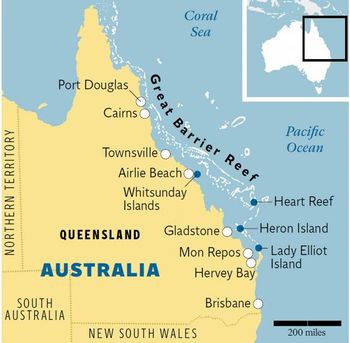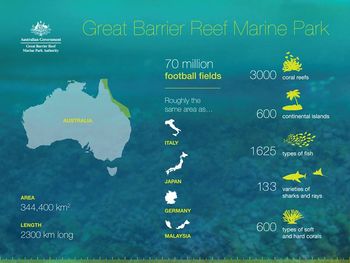SugarCane
The Impacts of the Sugar Cane Industry on the Great Barrier Reef
History of Australian Sugar Cane
Sugar cane was introduced to Australia in 1788, when the British First Fleet arrived to found the first European settlement on the continent. The settlers intended to create plantations for the valuable crop. Initial attempts to start a viable commercial sugar cane industry were unsuccessful, but attempts continued for many years. The first successful plantation was established in 1862, almost 75 years after the crop's introduction, and the first sugar mill was built two years later. [1]

Modern Industry
Today, sugar is one of the most important Australian crops. It is grown along the eastern coast of the continent, in the states of Queensland and New South Wales, and spans a range of roughly 2,100 kilometers of coastline. The nation exports around 80% of each year's sugar crop, making it the world's second largest exporter of raw sugar,[3] and the industry has an annual gross production value that exceeds $1 billion. [4]
While some sugar cane is grown in New South Wales, 95% of Australia's sugar production occurs in Queensland, the state bordering the Great Barrier Reef. The sugar crop grown in New South Wales is mostly sold for domestic processing and use. In contrast, almost all of the nation's exported sugar comes from Queensland.[3]
Impacts
Much of the runoff from sugar cane production in Queensland drains into the Great Barrier Reef lagoon, where it negatively impacts corals by increasing the suspended sediment and nutrient loads in the bay and by introducing agricultural pesticides.[5] High concentrations of suspended solids are detrimental to corals in a variety of ways. While in suspension, they reduce water clarity, limiting the amount of light that can reach corals and be available to their zooxanthellae for photosynthesis. Suspended solids also reduce the feeding efficiency of the corals themselves, inhibit their reproduction, and can cause mortality when they settle on top of coral colonies.[6] Sugar cane runoff also contributes to nutrient loading and eutrophication by washing excess fertilizers and organic material off of fields and into waterways. Nutrient-enriched or eutrophic conditions cause phytoplankton blooms and increased macroalgae growth.[7] When large phytoplankton blooms occur, they can reduce light penetration in the same manner than suspended solids do, and their rapid proliferation can use up important nutrients, especially phosphorus, leaving waters around corals nutrient-poor by the time the bloom dies off. Increased macroalgae growth in areas where corals have experienced bleaching or mortality, on the other hand, causes competition for the hard substrates juvenile corals need to settle on, preventing new coral recruitment.[7]
Pesticides
Sugar cane fields are treated with a number of pesticides. In particular, the photosynthesis-inhibiting herbicides diuron, atrazine, hexazinone, and ametryn are applied to prevent the growth of broadleaf weeds and smaller grasses in sugar cane agricultural areas. All four herbicides have been found draining into the Great Barrier Reef lagoon from areas where sugar cane agriculture is one of the dominant land-use types. The concentration of many pesticides downstream from sugar cane production sites has also been found to exceed the maximum concentrations outlined by various water quality guidelines and standards.[5] The use of some of these pesticides has increased recently because of an expansion in the total land area devoted to sugar cane between 1977 and 1996.[8]
Diuron and atrazine both have acute exposure impacts on corals at very low doses. Ross Jones et al. of the University of Queensland experimentally exposed four species of corals to varying concentrations of diuron and atrazine for short lengths of time. They found that the herbicides reduced photosynthetic efficiency (measured by effective quantum yield) in the corals' zooxanthellae after ten hours of exposure at concentrations as low as 1 part per billion (ppb) for diuron and 3 ppb for atrazine.[9]
The corals did recover quickly from acute exposure. The experiment found that after 250 minutes of exposure to 10 ppb diuron concentrations, the photosynthetic efficiency of the corals recovered to within 25% of the baseline measure within 40 to 120 minutes, depending on the coral species.[9] However, exposure to these pesticides in the Great Barrier Reef lagoon is much more severe than what the corals in the experiment were exposed to. Pesticide runoff from sugar cane fields can be on the order of hundreds of kilograms per runoff event, which lasts three to five days, and reefs are essentially under chronic pesticide exposure.[5]
Mitigation Strategies and Solutions
Australian Government’s Reef Rescue Program
The government-initiated Reef Rescue Program, based in Queensland, is the first phase of $200 million project between the government and farmers to reduce runoff from farms and improve water quality near coral reefs.[10] Under this program, farmers have created artificial wetlands in the middle of sugarcane fields, which traps runoff before it can escape to rivers that empty into the Great Barrier Reef lagoon.[10] The Reef Rescue Program has also supported other initiatives, like Underground Trickle Tape Irrigation, which allows plants to be given a more specifically measured amount of water.[10] This type of irrigation gives farmers more ability to capture and reuse extra water, instead of losing it to runoff.
Sugar Industry Reform Program (SIRP)
The SIRP was established in 2004.[11] This program promotes long-term reform of the sugarcane industry, economically, socially and environmentally.[11] 335 million dollars was allocated to different things like business planning, sustainability grants and retraining.[11] Under this program, Regional Advisory Groups have helped promote local reforms and helped identify key problems/solutions within each region.[11]
Project Catalyst
Project Catalyst is a partnership between companies such as The Coca-Cola Foundation, and local sugarcane farmers.[12] This project supports farmers by methods such as sharing information on new and innovative practices, water quality, farm economic viability among other methods. [12] Today, farmers are involved on over 15,000 hectares.

Game Changer
The Game Changer is funded by the Australian's government Reef Program.[14] The main goal of "The Game Changer" is to reduce the ecological footprint of sugarcane production on quality of freshwater by reducing the amount of nitrogen and herbicides in runoff. [14] Many different types of groups are involved in this program--from family farms to large enterprises. There are regular meetings and events to bring farmers together. [14] One example of a solution from this initiative is the use soil mapping to identify zones in sugarcane plantations that can be managed differently, so some areas don’t need as much fertilizer as others. [14] This initiative has reduced the need for fertilizers in different areas. [14]
Outcomes
Since most of the initiatives that have been put in place to improve the effects of the sugarcane indsutry on the Great Barrier Reef are fairly recent, it is hard to determine how much they are helping so far. Some intivatives such as the Underground Trickle Tape Irrigation hasn't had an impact on profit or productivity, which is a good sign.[10] Many people are also involved in the Game Changer program--large enterprises, small and large farms, signifying that it has had a far reach in Australia.[14] Each year, good farming practices increase so there is hope that conditions will be improving in the future.
References
- ↑ The History of the Sugar Industry. (n.d.). Retrieved from http://www.sugarmuseum.com.au/the-history-of-the-sugar-industry/
- ↑ Digital Image. Web. <http://www.independent.co.uk/travel/ausandpacific/the-great-barrier-reef-david-attenborough-returns-to-the-spectacular-natural-wonder-for-the-bbc-a6789991.html>.
- ↑ 3.0 3.1 Sugar. (2015). Retrieved from http://www.agriculture.gov.au/ag-farm-food/crops/sugar
- ↑ About Australian crop industries. (2015). Retrieved from http://www.agriculture.gov.au/ag-farm-food/crops/about-crops
- ↑ 5.0 5.1 5.2 Lewis, S. E., Brodie, J. E., Bainbridge, Z. T., Rohde, K. W., Davis, A. M., Masters, B. L., Maughan, M., et al. (2009). Herbicides: A new threat to the Great Barrier Reef. Environmental Pollution, 157(8-9), 2470–2484. doi:doi:10.1016/j.envpol.2009.03.006
- ↑ Ricardo, G. F., Jones, R. J., Negri, A. P., & Stocker, R. (2016). That sinking feeling: Suspended sediments can prevent the ascent of coral egg bundles. Scientific Reports, 6. Retrieved from http://www.nature.com/articles/srep21567
- ↑ 7.0 7.1 D’Angelo, C., & Wiedenmann, J. (2014). Impacts of nutrient enrichment on coral reefs: new perspectives and implications for coastal management and reef survival. Current Opinion in Environmental Sustainability, 7, 82–93. Retrieved from http://www.sciencedirect.com/science/article/pii/S1877343513001917
- ↑ Johnson, A. K. L., and Ebert, S. P. (2000). Quantifying inputs of pesticides to the Great Barrier Reef Marine Park – a case study in the Herbert River catchment of north-east Queensland. Marine Pollution Bulletin, 41(7-12), 302–309
- ↑ 9.0 9.1 Jones, R. J., Muller, J., Haynes, D., & Schreiber, U. (2003). Effects of herbicides diuron and atrazine on corals of the Great Barrier Reef, Australia. Marine Ecology Progress Series, 251, 153–167. Retrieved from http://www.int-res.com/articles/meps2003/251/m251p153.pdf
- ↑ 10.0 10.1 10.2 10.3 "Sweet methods: Queensland sugar cane growers reducing water run-off". (2013). Retrieved from http://www.abc.net.au/news/2013-06-14/sugar-cane-north-queensland-water-run-off/4754822
- ↑ 11.0 11.1 11.2 11.3 "Sugar". (nd). Retrieved from http://www.agriculture.gov.au/ag-farm-food/crops/sugar#sugar-industry-assistance-and-reform
- ↑ 12.0 12.1 "Project Catalyst". (nd). Retrieved from http://www.wwf.org.au/about_us/working_with_business/project_sponsorships/project_catalyst/
- ↑ Digital Image. Web. <http://www.gbrmpa.gov.au/about-the-reef/facts-about-the-great-barrier-reef>.
- ↑ 14.0 14.1 14.2 14.3 14.4 14.5 "Innovations in sugar cane farming Case study". (nd). Retrieved from http://www.environment.gov.au/marine/gbr/case-studies/sugar-cane-farming